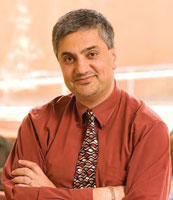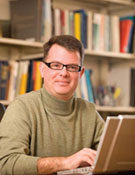Researching the Mysteries of Complex Systems
12:15 lunch @ sandwich shop? You hit "send" and seconds later your email arrives in your colleague's inbox. The reply is almost instantaneous: Sure.
With your email, you've connected in a most conventional 21st-century way. But consider that act more closely and you see how truly complex it is. With a click of a button, you communicated with your social circle using a computer to access the Internet, an information network that rides on a physical structure of lines and cables powered by the electrical grid that is fueled by the environmental system which, coming full circle, affects our social system. A simple function is actually extremely complicated. And the Internet is just one example of the many complex systems surrounding us.
A World of Challenges
Fueled by 50 years of dramatic technological advances, our world is now a series of complex systems, networks made up of hundreds, thousands, and even millions of dynamic parts or "nodes"-computers, people, cars, businesses, power plants, roads-linked together and intertwined with other networks. "We live in a networked world and the networks themselves are internetworked or interconnected," says Chaouki Abdallah, chair of the Electrical and Computer Engineering Department. "When we meet a friend for lunch at a sandwich shop, we're dependent on the food distribution network, which relies on the transportation network, which is affected by the financial system. What makes such man-made networks even more complex are networks of people and the decisions they make. People affect physical networks and are affected by them."
These complex systems offer vast opportunities for economic development, information exchange, social networking, problem solving, and much more. They also present daunting challenges and immense liabilities in terms of management, security, and functionality. Complex systems have politicians, engineers, scientists, and business leaders asking: What is the best way to fix a critical network like our nation's transportation system? How can you insulate the financial network from attack through the computer network? How do you protect our fragile environmental network from the impact of the transportation, energy, and social systems?
"The challenges faced by the world today are truly global in nature. They're too complex to be solved by an individual, a university, or even one country," explains Abdallah. Rising to these challenges demands a richer understanding of the complex interactions of technical, social, economic, and ecological factors. Finding solutions will require a revolutionary shift to a culture of innovation and the power of the most advanced technologies available. "The status quo and standard methods don't suffice in the realm of complex systems," says Joseph L. Cecchi, dean of the School of Engineering. "We'll find answers using unconventional thinking, new technologies and by building partnerships among different disciplines."
Around the world, and right here at UNM, multidisciplinary research teams led by engineers and computer scientists are using their expertise and technology to unravel some of the mysteries of complex systems. A recent study of network science commissioned by the National Academies shows that America is the world leader in complex systems research and New Mexico is eighth in the nation in the discipline.
Education is Key
Finding solutions to complex systems problems is happening in the laboratory and the classroom. "Educating future students to innovate in response to world challenges will require new approaches, including a broader curriculum, increased understanding of diverse cultures and global markets, and hands-on experience in technology transfer and commercialization," says Cecchi.
SOE graduate students can already take courses in complex systems and reconfigurable systems as well as workshops and seminars that venture into new realms of complex systems research. A current graduate seminar links neuroscience and engineering to study the ultimate complex system: the brain. The class focuses on the development and organization of complex systems linking behavior, cognition, and technology. Speakers include a professor of neurology and psychology from The Mind Research Network, a non-profit neuroscience research center in Albuquerque where UNM is a member, senior researchers from Sandia National Laboratories, and world-renowned experts on neuroscience and complex systems.
Undergraduate students get the solid foundation they need in engineering and their area of interest while they learn to think in a "systems" way through group projects. "We are moving away from traditional engineering where a person would focus on one component or structure," says Charles Fleddermann, associate dean for academic affairs. "Now we look at things on a systems level and how disparate elements in a system work together."
Complex Collaborations
Back in the labs, SOE faculty members from different departments are collaborating with other UNM researchers-mathematicians, sociologists, physicists, and more-to study complex systems. "We're using our expertise which was focused on specific problems and we're connecting with each other," says Abdallah. In doing so, UNM research teams are making connections that will help solve some of the world's biggest challenges.
Chaouki Abdallah
Testing Teleautonomy
When the researcher at the University of Illinois (U of I) moved the joystick handle, it triggered a command that sped across the Internet. A thousand miles away in the basement of the Electrical and Computer Engineering building on the UNM campus, Chaouki Abdallah and his team of students watched as one large robot and eight small slave robots began to move in formation. As the robots approached a wall, they relayed a signal to the U of I researcher who sensed pressure in the joystick and pulled back, maneuvering the robots out of harm's way.
By using the Internet to control the robots, the two research teams successfully completed a teleautonomy research project funded by the National Science Foundation. The team received a $400,000 NSF grant for the project, which started in 2002 and was completed in 2005.
Researchers at the U of I handled the "tele," or movement part of the project while Abdallah and his team managed the "autonomy" aspect, how the robots configured themselves and used resources based on commands sent from U of I. To do that, the robots used a physical control protocol that Abdallah adapted from an Internet protocol that manages how much information each user can send.
Because the teams were operating a network across a shared network, Abdallah and his team had to account for congestion on the Internet and factor it into the process. The team found that the delay between sending a command and receiving it averaged 15 milliseconds, but could spike to a minute or more. "It's very important that the delays are accounted for or you're going to crash," says Abdallah. "The challenge is how to manage delays in systems that have changing dynamics."
Abdallah says that this research illustrates how a complex network can be used to interact and control systems across large distances, with applications ranging from tele-surgery to using an earth-based mechanism to control robots constructing structures on other planets.
Bert Tanner
1+1=3
 Through his research on hybrid systems, Bert Tanner, professor of mechanical engineering, is studying how the whole can be greater than the sum of its parts. Hybrid systems are networks of dynamic, heterogeneous elements with both discreet and continuous behaviors. Tanner is researching ways to capitalize on the differences and cooperation between the elements in a hybrid system. "It's all about bringing together resources from different, small, interconnected systems that are spread across networks and exploiting them," he explains. An orchestra is an apt metaphor for his work. Each musician can play alone, but when all the musicians play the same score under the direction of a conductor, they produce a different, more elaborate musical performance. One of Tanner's first challenges is to mathematically describe all of the elements in a hybrid system, bringing codes, programs, logic, mechanical devices, electronics, and more together in a single framework.
Through his research on hybrid systems, Bert Tanner, professor of mechanical engineering, is studying how the whole can be greater than the sum of its parts. Hybrid systems are networks of dynamic, heterogeneous elements with both discreet and continuous behaviors. Tanner is researching ways to capitalize on the differences and cooperation between the elements in a hybrid system. "It's all about bringing together resources from different, small, interconnected systems that are spread across networks and exploiting them," he explains. An orchestra is an apt metaphor for his work. Each musician can play alone, but when all the musicians play the same score under the direction of a conductor, they produce a different, more elaborate musical performance. One of Tanner's first challenges is to mathematically describe all of the elements in a hybrid system, bringing codes, programs, logic, mechanical devices, electronics, and more together in a single framework.
"As today's engineering systems grow more complex, I see the need for a new framework that captures what we want to do with these systems," says Tanner. He is using a variety of techniques from theoretical computer science, complex networks, modeling, simulation, and control theory to create these unifying mathematical models.
Tanner and one of his doctoral students, Wengi Zhang, are close to finishing a theoretical framework. Their first test of the framework will be on a sliding tile puzzle that would solve itself. Each tile in the puzzle will be an independent node or "agent," and an enabling agent will push and pull the tiles around. Findings from the project will add another critical piece in the larger puzzle of complex systems.
Rafael Fierro
Dynamic Network Experiments
A team of small robots explores a dangerous area filled with noxious fumes. Several unmanned aerial vehicles scan the land below for a target. Both scenarios are examples of dynamic networks: decentralized systems of heterogeneous nodes that work together to achieve a specific mission. Rafael Fierro, professor of electrical and computer engineering, is interested in exactly how these networks coordinate to achieve their mission.
In particular, Fierro is trying to develop a systematic, computational approach for the analysis and design of these decentralized systems that can be repeated with a high degree of confidence. "Past research has been ad hoc," he comments. "You do something but you can't be guaranteed that it will work the same next time. The goal is to develop some kind of repeatable algorithm."
What differentiates Fierro's work goes beyond the theoretical. "My work is experimentally motivated," he says. "I develop a solid theory and then validate it on actual hardware." In one experiment, he created his own dynamic network of robots equipped with sensors and cameras that navigate in an environment while avoiding collisions, differentiating intruders, and hypothesizing a trajectory to intercept the intruders.
He has also applied his ideas to a robotic version of Marco Polo, the classic swimming pool search game, and other games that are being developed with the partial support of the NSF. The goal of this project is to explore various aspects of robot/human interaction and help encourage children's interest in engineering.
Fierro's work is inspired by other disciplines including biology, computer science, and electrical engineering. "It's quite challenging because you need to understand several disciplines in order to create a coherent framework," he says. "That's what makes this interesting." His work could apply to many key areas of complex systems including homeland security, search and rescue, autonomous sampling networks for oceanographic applications, stability of the energy grid, and more.
